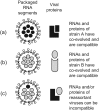Implications of segment mismatch for influenza A virus evolution
- PMID: 29244017
- PMCID: PMC5882089
- DOI: 10.1099/jgv.0.000989
Implications of segment mismatch for influenza A virus evolution
Abstract
Influenza A virus (IAV) is an RNA virus with a segmented genome. These viral properties allow for the rapid evolution of IAV under selective pressure, due to mutation occurring from error-prone replication and the exchange of gene segments within a co-infected cell, termed reassortment. Both mutation and reassortment give rise to genetic diversity, but constraints shape their impact on viral evolution: just as most mutations are deleterious, most reassortment events result in genetic incompatibilities. The phenomenon of segment mismatch encompasses both RNA- and protein-based incompatibilities between co-infecting viruses and results in the production of progeny viruses with fitness defects. Segment mismatch is an important determining factor of the outcomes of mixed IAV infections and has been addressed in multiple risk assessment studies undertaken to date. However, due to the complexity of genetic interactions among the eight viral gene segments, our understanding of segment mismatch and its underlying mechanisms remain incomplete. Here, we summarize current knowledge regarding segment mismatch and discuss the implications of this phenomenon for IAV reassortment and diversity.
Keywords: evolution; evolutionary constraint; influenza A virus; packaging; reassortment; segment mismatch.
Conflict of interest statement
The authors declare that there are no conflicts of interest.
Figures



References
-
- Shaw ML, Palese P. Orthomyxoviridae. In: Knipe D, Howley P, editors. Fields Virology. Philadelphia, PA: Lippincott Williams & Wilkins; 2013. pp. 1151–1185. (editors)
Publication types
MeSH terms
Substances
Grants and funding
LinkOut - more resources
Full Text Sources
Other Literature Sources

